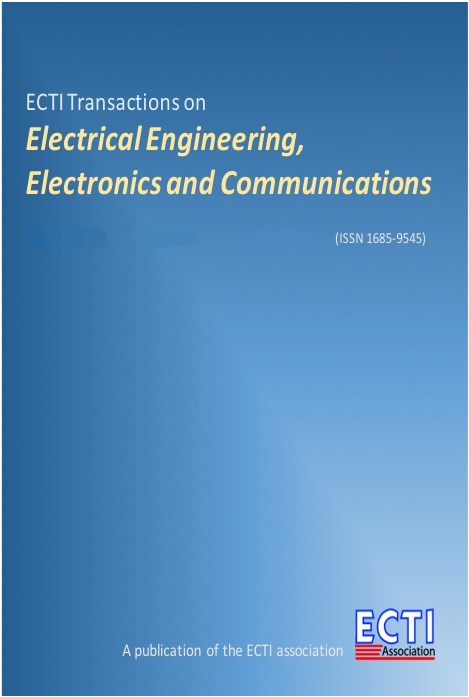Optimal Neuro-Fuzzy Equalizers for Detecting Nonlinear Distortion Channels of the Perpendicular Magnetic Recording System
Main Article Content
Abstract
Nonlinear distortions caused by partial erasure and nonlinear transition shifts interacting with inter-symbol interference, are a major hindrance to data storage systems, since they degrade detector performance. This work aims to design and optimize the neuro-fuzzy equalizer (NFE) using the multi-objective genetic algorithm (MOGA) to detect nonlinear high-density magnetic recording (MR) channels. Through the GA-assisted back-propagation algorithm and least mean square optimization, the complexity in terms of decision rules is reduced by 25% and significantly provides 65% lower signal processing computation. When applied to the perpendicular (MR) system, the proposed NFE outperforms existing equalizers such as the neural network-based equalizer, fuzzy logic equalizer, and conventional NFE for the Volterra and jitter media noise channels using 1–3 dB and 1.5–3.5 dB signal-to-noise ratio gains at the bit-error-rate of 10-4, respectively. Furthermore, compared to the other models, the NFE provides a more effective output mean square error performance for retrieving the original bit data.
Article Details
This journal provides immediate open access to its content on the principle that making research freely available to the public supports a greater global exchange of knowledge.
- Creative Commons Copyright License
The journal allows readers to download and share all published articles as long as they properly cite such articles; however, they cannot change them or use them commercially. This is classified as CC BY-NC-ND for the creative commons license.
- Retention of Copyright and Publishing Rights
The journal allows the authors of the published articles to hold copyrights and publishing rights without restrictions.
References
R. Wongsathan and P. Supnithi, “The performance of neuro-fuzzy detection on nonlinear magnetic recording channels,” in 34th International Technical Conference on Circuits/Systems, Computers and Communications (ITC-CSCC), Jeju, Korea, 2019.
Z. Wu, P. H. Siegel, J. K. Wolf, and H. N. Bertram, “Analysis of nonlinear transition shift and write precompensation in perpendicular recording systems,” IEEE Journal on Selected Areas in Communications, vol. 28, no. 2, pp. 158–166, 2010.
Y. Wang, R. H. Victora, and M. F. Erden, “Two-dimensional magnetic recording with a novel write precompensation scheme for 2-D nonlinear transition shift,” IEEE Transaction on Magnetics, vol. 51, no. 4, pp. 1–7, 2015.
H. Yang and G. Mathew, “Joint design of optimum partial response target and equalizer for recording channels with jitter noise,” IEEE Transaction on Magnetics, vol. 42, no. 1, pp. 70–77, 2006.
Z. Wu, P. H. Siegel, J. K. Wolf, and H. N. Bertram, “Mean-adjusted pattern-dependent noise prediction for perpendicular recording channels with nonlinear transition shift,” IEEE Transaction on Magnetics, vol. 44, no. 11, pp. 3761–3764, 2008.
T. R. Oenning and J. Moon, “The effect of jitter noise on binary input intersymbol interference channel capacity,” in ICC 2001 IEEE International Conference on Communication, Helsinki, Finland, August 2002.
S. V. Vaerebergh, J. Via, and I. Santamana, “A sliding-window kernel RLS algorithm and its application to nonlinear channel identification,” in International conference on Acoustics, Speech, and Signal Processing, ICASSP-88, 1988, pp. 789–792.
R. Wongsathan, W. Phakphisut, and P. Supnithi, “Performance of the hybrid MLPNN based VE (hMLPNN-VE) for the nonlinear PMR channels,” AIP Advances, vol. 8, pp. 1–5, 2018.
M. Yamashita et al., “Modeling of writing process for two-dimensional magnetic recording and performance evaluation of two-dimensional neural network equalizer,” IEEE Transaction on Magnetics, vol. 48, no. 11, pp. 4586–4589, 2012.
R. Wongsathan and P. Supnithi, “Fuzzy logicbased adaptive equalizer for non-linear perpendicular magnetic recording channels,” IET Communications, vol. 13, no. 9, pp. 1304–1310, 2019.
T. Cavdar, “PSO tuned ANFIS equalizer based on fuzzy C-means clustering algorithm,” International Journal Electronics and Communications (AEÜ), vol. 70, no. 6, pp. 799–807, 2016.
W. R. Eppler and I. Ozgunes, “Channel characterization method using dipulse extraction,” IEEE Transaction on Magnetics, vol. 42, no. 2, pp. 176–181, 2006.
M. Madden, M. Oberg, Z.Wu, and R. He, “Read channel for perpendicular magnetic recording,” IEEE Transaction on Magnetics, vol. 40, no. 1, pp. 241–246, 2004.
R. Hermann, “Volterra modeling of digital magnetic saturation recording channels,” IEEE Transaction on Magnetics, vol. 26, pp. 2125–2127, Sept. 1990.
W. Tan and J. Cruz, “Signal processing for perpendicular recording channels with intertrack interference” IEEE Transaction on Magnetics, vol. 41, no. 2, pp. 730–735, 2005.
G. Mathew and I. Tjhia, “Thermal asperity suppression in perpendicular recording channels,” IEEE Transactions on Magnetics, vol. 41, no. 10, pp. 2878–2880, 2005.
H. Osawa, T. Shimizu, T. Nakaoka, Y. Okamoto, H. Saito, H. Muraoka, and Y. Nakamura, “Simplification of neural network equalizer for perpendicular magnetic recording,” Electronics and Communications in Japan (Part II: Electronics), vol. 89, no. 2, pp. 19–27, 2006.
H. Osawa, M. Hino, N. Shinohara, Y. Okamoto, Y. Nakamura, and H. Muraoka, “Simplified neural network equalizer with noise whitening function for GPRML system” IEEE Transaction on Magnetics, vol. 44, no. 11, pp. 3777–3780, 2008.
R. Wongsathan, W. Phakphisut, and P. Supnithi, “Neural networks equalizers for nonlinear magnetic recording channels” in 14th International Conference on Electrical Engineering/Electronics, Computer, Telecommunications and Information Technology (ECTI-CON), Phuket, Thailand, 2018.
L. X. Wang and J. M. Mendel, “Fuzzy adaptive filters, with application to nonlinear channel equalization,” IEEE Transaction on Fuzzy Systems, vol. 1, no. 3, pp. 161–170, 1993.
K. Y. Lee, “Complex fuzzy adaptive filter with LMS algorithm” IEEE Transaction on Signal Processing, vol. 44, no. 2, pp. 424–427, 1996.
W.K. Wong and H.S. Lim, “A robust and effective fuzzy adaptive equalizer for powerline communication channels,” Neurocomputing, vol. 71, no. 1–3, pp. 311–322, 2007.


